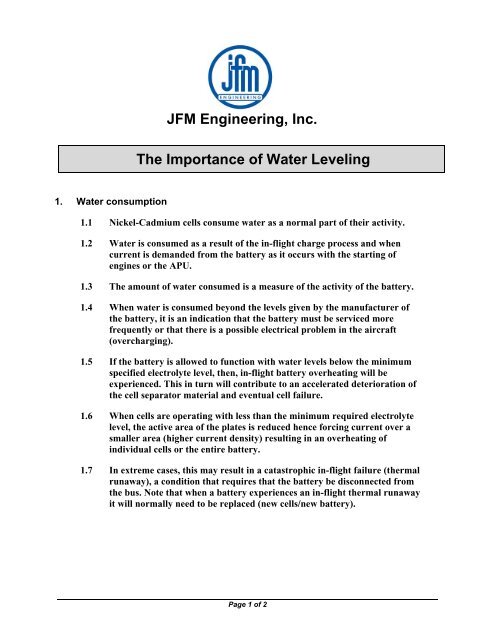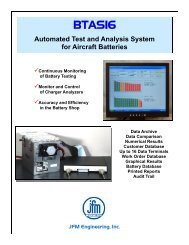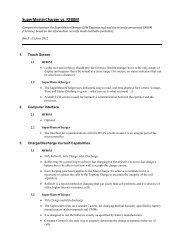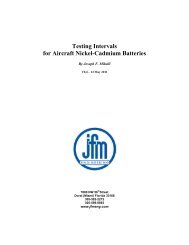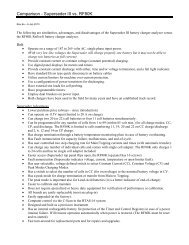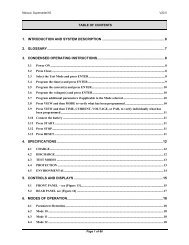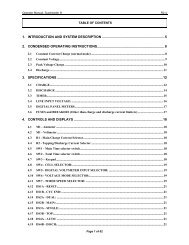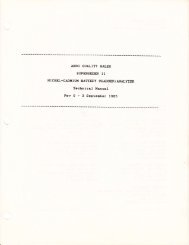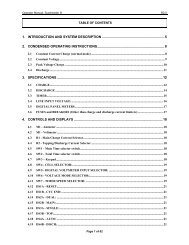JFM Engineering, Inc. The Importance of Water Leveling
JFM Engineering, Inc. The Importance of Water Leveling
JFM Engineering, Inc. The Importance of Water Leveling
Create successful ePaper yourself
Turn your PDF publications into a flip-book with our unique Google optimized e-Paper software.
<strong>JFM</strong> <strong>Engineering</strong>, <strong>Inc</strong>.<strong>The</strong> <strong>Importance</strong> <strong>of</strong> <strong>Water</strong> <strong>Leveling</strong>1. <strong>Water</strong> consumption1.1 Nickel-Cadmium cells consume water as a normal part <strong>of</strong> their activity.1.2 <strong>Water</strong> is consumed as a result <strong>of</strong> the in-flight charge process and whencurrent is demanded from the battery as it occurs with the starting <strong>of</strong>engines or the APU.1.3 <strong>The</strong> amount <strong>of</strong> water consumed is a measure <strong>of</strong> the activity <strong>of</strong> the battery.1.4 When water is consumed beyond the levels given by the manufacturer <strong>of</strong>the battery, it is an indication that the battery must be serviced morefrequently or that there is a possible electrical problem in the aircraft(overcharging).1.5 If the battery is allowed to function with water levels below the minimumspecified electrolyte level, then, in-flight battery overheating will beexperienced. This in turn will contribute to an accelerated deterioration <strong>of</strong>the cell separator material and eventual cell failure.1.6 When cells are operating with less than the minimum required electrolytelevel, the active area <strong>of</strong> the plates is reduced hence forcing current over asmaller area (higher current density) resulting in an overheating <strong>of</strong>individual cells or the entire battery.1.7 In extreme cases, this may result in a catastrophic in-flight failure (thermalrunaway), a condition that requires that the battery be disconnected fromthe bus. Note that when a battery experiences an in-flight thermal runawayit will normally need to be replaced (new cells/new battery).Page 1 <strong>of</strong> 2
2. Ground Service2.1 When batteries are ground serviced, distilled water is added at the end <strong>of</strong>the charge and the amount <strong>of</strong> water delivered is recorded for each <strong>of</strong> thecells.2.2 In the electrochemical process in the cells, water is absorbed by the platesduring discharge and water is released during charge. It is for this reasonthat the only time when the electrolyte level can be tested and adjusted is atthe end <strong>of</strong> the charge process (topping charge). Typically, when cells reach1.6V or higher.2.3 If water is added at other than at full charge, there is the danger thatspilling <strong>of</strong> electrolyte will take place when the battery reaches full charge.When the water evaporates, there will be a conductive white residue(Potassium Carbonate) deposited over the cell top, links and posts giving aclear indication <strong>of</strong> overfilling.2.4 An exception to the when-to-add-water-rule is if a high cell voltagedevelops during charge (usually over 2V). This is an indication that the cellis “dry”. At this time, an injection <strong>of</strong> 10cc to 20cc will bring the cell voltagesto normal levels.2.5 It is also advised to initially dispense 5cc to 10cc on each cell for a batterythat has a known history <strong>of</strong> high water consumption or if the battery hasremained on the shelf for a prolonged period <strong>of</strong> time.2.6 Uneven water consumption can be an indication <strong>of</strong> cell imbalance, cell ageand cell damage.2.7 Battery overheating during bench charging can be the result <strong>of</strong> low initialelectrolyte levels.2.8 <strong>The</strong> CMM for each battery/cell provides the basic information <strong>of</strong>consumable water level as a guide to determine when the electrolyte lossbecomes excessive.3. Summary3.1 It is for all <strong>of</strong> these reasons that measurement and recording <strong>of</strong> water levelsduring bench charging must be performed to obtain a more completepicture <strong>of</strong> the condition <strong>of</strong> the battery.Page 2 <strong>of</strong> 2


